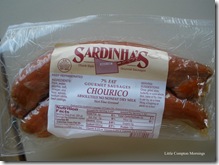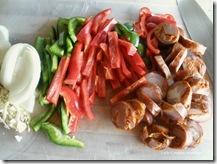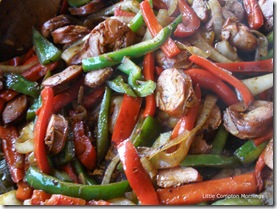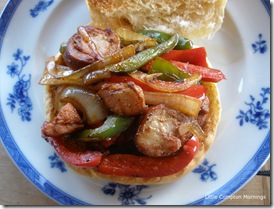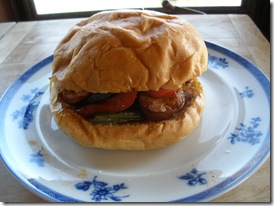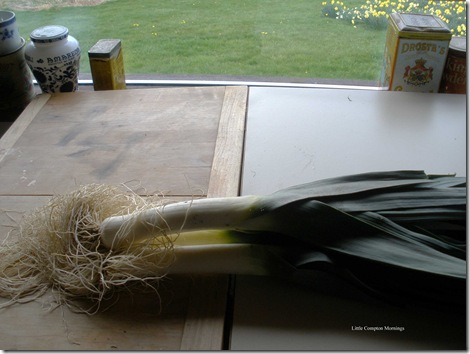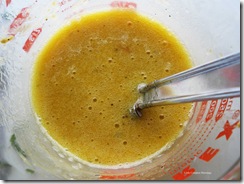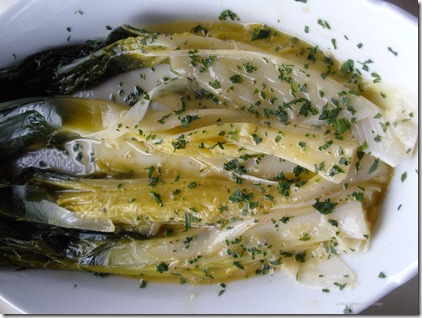
On the other side of the Bay from
thick jonnycake country—my side—the thin jonnycake reigns. As is the case with so many things, it’s the same, but different. The thin jonnycake is made from the identical stone-ground white flint cornmeal—although over here we use a different brand—and it too is served with butter and
maple syrup. But instead of a plopable fried mush made with boiling water, it is a pourable fried batter made with cold milk. It is largish and round rather than oval and small. It has a smoother, lightly crisp rather than rougher, crunchier surface—I suppose you could say it is more refined (although still down-home)—and has a lacy frill at the edge. People are very particular about the lace, which provides the thin jonnycake’s pleasant contrast of crispness and tenderness.
These differences in preparation do result in a different taste. The bittersweet tang is still there, but less density means less intensity. Eating thin jonnycakes is like eating breakfast pancakes that taste like nothing else you’ve ever had: they look similar, until you take a bite. Jonnycakes are, in fact, the pancake substitute in another unique Rhode Island tradition, the May Breakfast (at least, in those where tradition is inviolable—some have replaced them with the less-temperamental standard pancake).
In a state that loves controversy, there is disagreement over the origin of the May Breakfast. One theory is that it was first started to celebrate Rhode Island’s declaration of independence from the British crown on May 4, 1776—two months before the official declaration of the colonies. Another is that it began in the mid 19th century with a “May Day” fund-raiser for a new building for the Quaker meeting house in Cranston. I lean toward the first explanation, although it is true that nowadays most May Breakfasts are sponsored by churches or civic organizations to raise money, serving up good food for a good cause.
Like the public clambakes that are held all over Rhode Island throughout the summer,
May Breakfasts are held all over the state, usually between the first and seventh of the month, although a few have resorted to late April in a crowded field. Check your local papers, as most are not widely advertised. In addition to jonnycakes, there is usually ham and bacon (sometimes chorizo), eggs, clam cakes (I’ll get to those eventually),
baked beans, pie, juice, and coffee; at some, there are the more modern additions of home fries, muffins and other baked goods, or the aforementioned alternate of pancakes. Food is served family style and a filling time is had by all. If you start practicing now, you will have perfected the
de rigueur lacey edge in time to hold your own May Breakfast. That is, if you decide to align with my side of the bay.
Having trouble choosing between thick and thin? Like Switzerland, you can remain neutral, welcoming and eating all, no questions asked. There is even what some call a “middle-of-the-bay” jonnycake, the ultimate political compromise, which uses both boiling water and cold milk; indeed, you may discover that many contemporary recipes for thin-style jonnycakes are written this way. You start with making a boiling-water mush, and add cold milk to thin. It is not traditional, but it is easier to cook, as is the
faux or near-jonnycake, which contains flour and sometimes egg, that is sometimes passed off in restaurants as the real thing. To say nothing of the fancy ones, flavored with juice, liqueur, spice, or other new-fangled additions.
Me, I like jonnycakes in any guise. But I hew to the old ways when I make them at home—through thick or thin.
East of Bay Jonnycakes
The local cornmeal on this side of the water is
Gray’s, from a small grist mill in the village of Adamsville on the Westport, Massachusetts/Little Compton, Rhode Island line. For a brief, shining moment (actually, a few years) during the 1990s, Gray’s milled an amazing coarse-grain yellow meal that made the most sensational polenta I have ever had. When they stopped making it, I bought up as many bags as possible and hoarded the final one in the freezer for—I’m somewhat embarrassed to say—years, even twice moving house with it. Alas, I was compelled to use it up at a certain point when it was starting to yield a slightly off taste, and it is now gone forever. But the memory lingers on.
Serves 4 (about 12 5” cakes).
1 cup Rhode Island stone-ground white flint cornmeal
½ tea salt

1 ½-2 cups whole milk
Use a spouted bowl or pitcher (preferably with a handle) to mix the batter. Warm the cornmeal in the oven and stir in the salt. Very gradually, stirring all the while, add the milk until you have a thin, soupy batter; start with between 1 ½ and 1 ¾ cups. Generously grease a medium-hot griddle with bacon fat or lard, and pour batter onto the griddle to make cakes about 5-6” diameter. If the temperature is right and the batter of proper consistency, the batter will immediately spread and bubble and holes will appear. Do not panic.

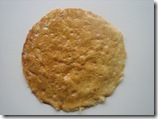

Cook undisturbed until the thin edges are brown, the surface has begun to dry, and you can easily slide a sharp, clean metal spatula beneath it. This will take 3-5 minutes, depending on your heat. Turn, revealing an evenly golden cake of crepe-like thinness with a frilly edge. Cook another 2 minutes or so; the bottoms will have the appearance of a perforated golden network.
The trick to cooking these is the thinness of the batter and the proper temperature. Too thick, and it will not spread to frill at the edges; add more milk, and do so throughout the cooking if the batter thickens will sitting. Too hot, and the cakes will burn; too low, and they won’t cook through. Test one before making a full batch, and adjust the heat as needed (usually, lower). Keep your spatula edge wiped clean.
You can hold jonnycakes warm in the oven while you cook the rest. Serve them on their own with butter and maple syrup, or alongside eggs and/or bacon, ham, or sausage.
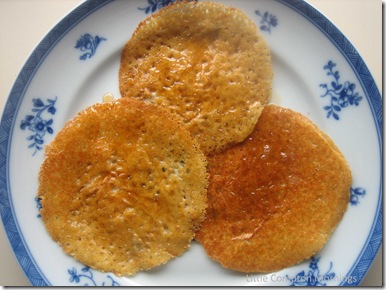 Notice: Voting for Rhode Island Monthly’s Best of Rhode Island is open, and there is a category for best local website. If you appreciate Little Compton Mornings and would like to show your support, you may vote here now: http://www.rimonthly.com/Rhode-Island-Monthly/Best-of-Rhode-Island/Best-of-Rhode-Island-Ballot/ . I thank you!
Notice: Voting for Rhode Island Monthly’s Best of Rhode Island is open, and there is a category for best local website. If you appreciate Little Compton Mornings and would like to show your support, you may vote here now: http://www.rimonthly.com/Rhode-Island-Monthly/Best-of-Rhode-Island/Best-of-Rhode-Island-Ballot/ . I thank you!
 When I moved a few years ago, one important box, out of all the arguably negligible boxes, never made it to my house. It contained my entire collection of plain and enameled cast iron cookware, plus countless heat-proof serving pieces, many of them (like the cast iron) near-antiques, and several of them gifts with sentimental as well as culinary value. Common items such as large cast iron skillets are easy to replace (although, of course, anyone who has owned one for a long time will tell you that their seasoned pan is irreplaceable). Other things are harder to re-acquire. Good enameled cast iron and decorative bakeware are, for starters, expensive; thoughtful, well-heeled friends have used holidays and other opportunities to help me rebuild my collection with generous gifts. But some pieces are just not available anymore: a shallow round enameled cast iron paella-type pan with integral cut-out handles, for example, a gift in the early 1970s; the first piece of enameled cast iron that I ever owned, a blue and cream small gratin, that I purchased on my first trip to Europe; a Victorian-era ceramic mold, bought for me by my mother when I saw it in an antique shop. Don’t even get me started about true cast-iron popover pans, with their odd number of 11 deep compartments, designed to leave room on each side of the pan for picking it up. Mine had been an Erie pan of my Pennsylvania German grandmother’s, so I estimate that it was nearly 100 years old or more when I lost it. My large skillet was hers, too. For me, such losses are far more painful than, for example, the loss of a favorite gold ring a number of years ago. I never think about that ring. But I think about these pans all the time.
When I moved a few years ago, one important box, out of all the arguably negligible boxes, never made it to my house. It contained my entire collection of plain and enameled cast iron cookware, plus countless heat-proof serving pieces, many of them (like the cast iron) near-antiques, and several of them gifts with sentimental as well as culinary value. Common items such as large cast iron skillets are easy to replace (although, of course, anyone who has owned one for a long time will tell you that their seasoned pan is irreplaceable). Other things are harder to re-acquire. Good enameled cast iron and decorative bakeware are, for starters, expensive; thoughtful, well-heeled friends have used holidays and other opportunities to help me rebuild my collection with generous gifts. But some pieces are just not available anymore: a shallow round enameled cast iron paella-type pan with integral cut-out handles, for example, a gift in the early 1970s; the first piece of enameled cast iron that I ever owned, a blue and cream small gratin, that I purchased on my first trip to Europe; a Victorian-era ceramic mold, bought for me by my mother when I saw it in an antique shop. Don’t even get me started about true cast-iron popover pans, with their odd number of 11 deep compartments, designed to leave room on each side of the pan for picking it up. Mine had been an Erie pan of my Pennsylvania German grandmother’s, so I estimate that it was nearly 100 years old or more when I lost it. My large skillet was hers, too. For me, such losses are far more painful than, for example, the loss of a favorite gold ring a number of years ago. I never think about that ring. But I think about these pans all the time. 



